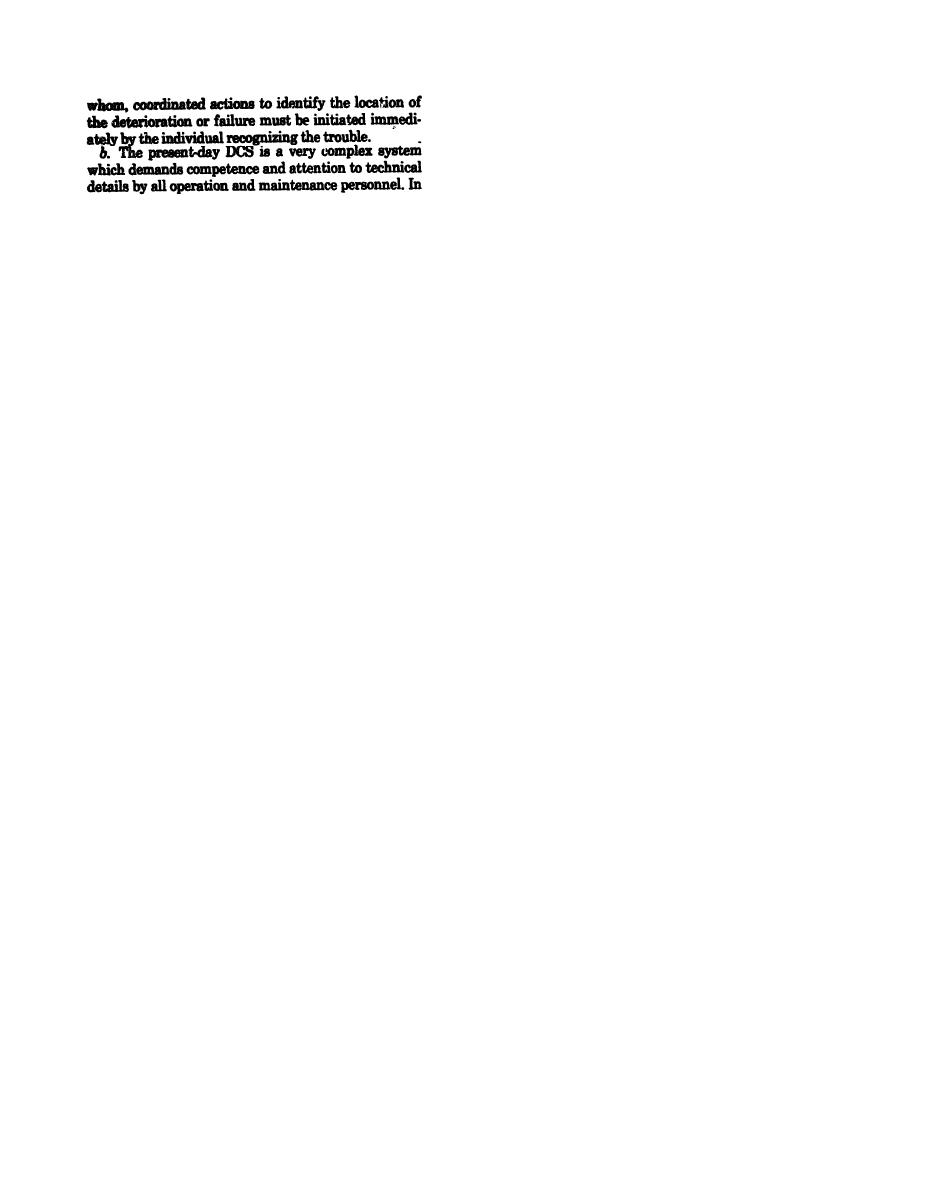 |
|||
|
|
|||
|
|
|||
| ||||||||||
|
|
 TM 11-5895-1012-10
input or output signal levels cannot be over-empha-
sized. One or two voice channels operating with exces-
sive signal levels can disrupt the entire baseband In
fact, high levels inserted into one channel can disrupt
other links or systems through which that signal is
routed. By the same token, a change in signal level at
a system such as the DCS, there is little room for error.
one point will affect the level at all subsequent points
Even the smallest error can easily be compounded into
in the system. Signal level adjustments must not be
a series of errors which can render a circuit, group, sys-
made without complete coordination with all locations
tem, or service completely unuseable. Every station
that can be affected. equipment adjustments made by
and link in the system was originally tested and ac-
Technical Controllers will normally be limited to oper-
cepted as meeting a specified level of performance. In
ational controls which are necessary for proper circuit
order to continue operating at that level, each and
or trunk operation; i.e., line current levels, composite
every one of the electrical standards must be main-
audio levels, mode changes, channel reduction, or
tained with the established parameters.
paralleling (twinning). They will not normally adjust,
c. The DCS is made up of many different types of
or attempt to adjust, any of the controls used for
equipment which perform identical functions, but do
equipment alignment.
not necessarily have the same electrical character-
(2) When a &graded condition or other trouble is
istics. For example, not all of the voice frequency chan-
encountered at a given station, the Technical Control-
nel multiplex equipments in the DCS are designed for
ler of that station coordinates with distant stations,
a - 16 dBm test tone level input to the voice frequency
local users, and associated transmitting and receiving
modulator. Because of the detail differences which
elements in his efforts to isolate and locate the fault.
exist, there are no cut and dried, test-point by test-
He has primary responsibility for this action, and must
point fault isolation procedures which cover all pos-
receive full cooperation from all other station Techni-
sible installations. There are certain functional areas
cal Controllers involved. When it is determined that
which are the same in all systems, regardless of the in-
the fault is located at a distant station, or in a link
stalled equipment The procedures given in this sec-
serving an area beyond that station, responsibility for
tion are addressed to functional areas rather than spe-
locating and correcting the fault is transferred to, and
cific signal and test tone levels at the various equip
assumed by, the station Technical Controller primarily
ments. In addition to general fault isolation proce-
concerned.
dures, specific fault isolation procedures for the more
c. User. The user is responsible for notifying the re-
common faults are also presented.
sponsible Technical Controller of all instances of serv-
ice degradation evidenced by high data error rates, oc-
4-25. Responsibilities
casional noise bursts into the voice channels serving
Responsiblity for maintaining the DCS at a high level
him, or other indications of unsatisfactory conditions.
of operation, rests not only with the DCS Stations and
The user renders free cooperative to the Technical
Technical Controllers, but also with the user, the DCA
Controller and the correction of service degradation.
and ACC Operations Centers, and Maintenance per-
d. DCA and ACC Operations Center.
sonnel.
(1) The Operations Centers monitor the progress
a DCS Station.
of the station Technical Controllers in their trouble-
(1) Each DCS Station is responsible for the
shooting efforts, but under normal circumstances,
development of local fault isolation procedures based
does not actively engage in the isolation of a fault. If
on the particular type of equipment installed in that
however, the station Technical Controllers encounter
station, the design capability of each link or system,
difficulties and cannot restore service within a reason-
patch panel and test point appearances, and test equip-
able period of time, the active Operations Center is re-
ment availability. The procedures clearly delineate
sponsible for assuming the overall direction of the cor-
those functions which will be performed by technical
rective actions, for providing a workable solution to
controllers and those which will be accomplished by
the problem, and for keeping circuit outage time to an
maintenance personnel.
absolute minimum.
(2) Each station should have ready reference
(2) Troubles encountered on multichannel or
charts at or near each patch panel or test point show-
multilink circuits often are of an accumulative nature
ing the required teat tone level, the signal and noise
and present a complicated condition for resolution. To
levels, and the allowable tolerance at that test point,
determine the cause, or causes of such a condition spe-
This data is gotten from the technical evaluation made
cial link and segment tests may be required. The DCA
at the time the equipment, link, or system was accept
and ACC are responsible for determining the require-
ed.
ments for such special tests on the basis of station re
(3) The requirement for maintaining the correct
|
|
Privacy Statement - Press Release - Copyright Information. - Contact Us |